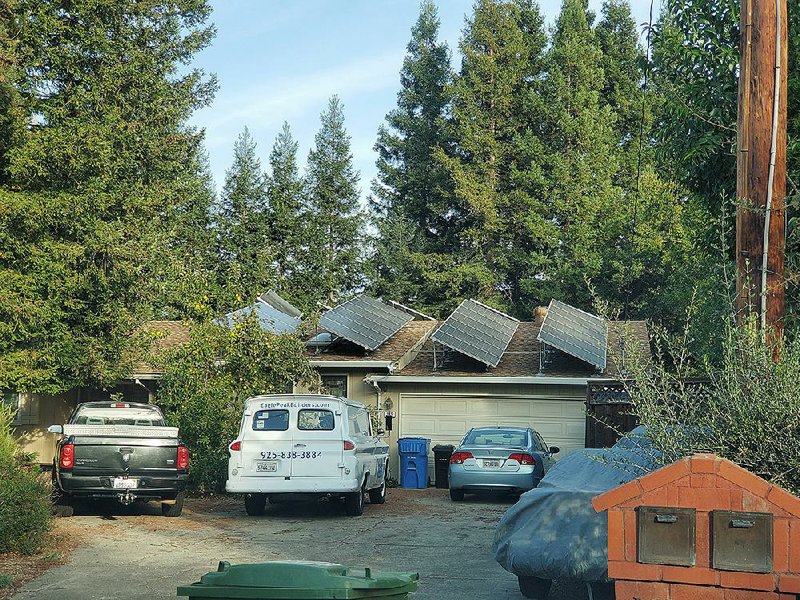A battle over where California will get its renewable power is poised to heat up in coming months -- as the thriving rooftop solar industry faces off with the state's most powerful electric utilities.
At stake is the extent to which solar power will be generated atop homes and businesses, as opposed to using solar arrays in the desert and other remote locations.
Experts say the outcome has the potential to dramatically influence the cost of power in the state -- and, by extension, the speed at which residents adopt electric appliances and cars.
Ratcheting up the tension, private purchases of solar panels have outpaced expectations over the past decade. Two former governors, Jerry Brown and Arnold Schwarzenegger, celebrated this week the installation of 1 million solar roofs across the state.
"We always have big goals here in California, and we go after it and build it," Schwarzenegger said at a news event in the Central Valley.
Advocates said the milestone has come despite escalating efforts by utilities to oppose rooftop solar installations. They said those attacks include everything from hefty fees on ratepayers to calling for dramatic cuts to the credits residents receive for generating energy from the sun.
Electricity providers across the state, from San Diego Gas & Electric to Redding Electric Utility, have said that they are not against rooftop solar in principle.
However, power companies have acknowledged their efforts to claw back money from residents with solar panels -- arguing that the state's program to compensate owners of rooftop solar, known as net metering, has resulted in higher rates for everyone else.
"The long-term implications for our non-solar customers are serious, because they will continue to see annual bill increases due to the solar subsidy," said San Diego Gas & Electric spokesman Wes Jones.
"We will seek sensible solutions that continue to encourage solar power but don't adversely affect working families who can't afford solar systems," he added.
Advocates have said that utilities are exaggerating the challenges that rooftop solar creates and downplaying the value it adds to the overall system.
"They trot out this cost-shifting argument that looks on the face of it like they care about equity, but really the opposite is true," said Dave Rosenfeld, executive director of the Solar Rights Alliance, a new consumer rights group funded by ratepayers and rooftop solar companies. "If you do the numbers right, solar is contributing to a reduction in the cost of operating the electricity grid now and in the future."
ROOFTOP FEES
Many electric service providers in California have, in recent years, adopted or recommended policies that've increasingly drawn the ire of the rooftop solar industry.
For example, the San Diego utility recently proposed raising its minimum bill from $10 a month to $38 a month. Officials were frank about their intentions to target solar customers. State regulators will consider the proposal in coming months.
The Sacramento Municipal Utility District floated a similar fee earlier this year but walked it back after a public outcry. The utility also caught flak from advocates after it proposed a work-around to the state's mandate that most new home construction include solar panels starting next year. Regulators have so far declined to approve the utility's idea, asking for more information on the proposal.
"With [the utility] in Sacramento, they are extremely hostile to rooftop solar," said Benjamin Davis, a policy associate with the California Solar and Storage Association. "Back in March, they tried to put a $40 to $50 per month fee on rooftop solar, which would have killed the cost effectiveness."
The Imperial Irrigation District went so far as to stop offering net metering compensation in 2016 to all new solar customers. The move was to "ensure that everyone pays their fair share for their use of the energy grid," according to the utility's website.
The Merced Irrigation District approved this year a $65-a-month fee on electricity customers who install solar panels starting in January.
At the same time, a bipartisan Solar Bill of Rights that would have, to a certain extent, prohibited such fees died earlier this year in the state Legislature after being heavily criticized by utilities.
"Clearly there's been a concerted effort to fear-monger on this idea of cost shifting," said Adam Browning, executive director of the national advocacy group Vote Solar.
SOLAR ECONOMICS
California's net metering program -- which determines how homeowners and businesses with solar panels are compensated -- is more than two decades old. Under the rules, customers essentially run their meters backward based on the solar power they put on the grid.
The program was attractive to Cindy Lingard, who recently installed about $29,000 worth of solar panels and battery storage on her home in El Cajon. She said she was inspired by her mother, who installed solar several years ago.
"I saw how well it worked out for her," said the 25-year-old Lingard, "so I knew I wanted solar and I knew I wanted the battery, so at night we don't have to worry about running the AC or the heater."
Sullivan Solar Power, which did the installation, estimated that its average customer can pay off such an investment in about seven years, given federal and state tax credits. Customers typically install just enough capacity to cover their usage because utilities offer very limited cash rebates for any excess power generated.
In some cases, homeowners can take out a loan with monthly payments roughly equal to what they pay for electricity without solar, said Tara Kelly, a spokeswoman with Sullivan Solar Power.
"People saving money is the number one reason why people are going solar today," she said. "[San Diego Gas & Electric] regularly has one of the highest electricity rates in the continental U.S., and SDG&E regularly has rate increases. Those reasons drive people to at least explore solar."
Business on 12/19/2019
